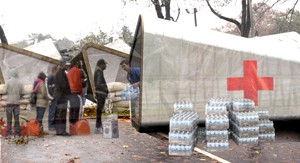
UC-Designed "Flat Pack Shelter" Set to Display at Prestigious New York Exhibit
The future of disaster shelters is flat.
Or at least thats the vision of faculty and students in the University of Cincinnatis architecture program.
Theyve designed an eight-foot tall, 18-foot-long shelter made of a plywood frame that could be covered in a shrink-wrap vinyl membrane for water proofing. Most importantly, it could be delivered flat packed and assembled by an ordinary family using readily available tools.
Because it can be flat packed, 25 of these shelters could fit (flat packed) on the bed of a standard tractor trailer of 53 feet in length.
(When flat packed, the shelters measure 4 feet wide, 4 feet high and 10 feet long.)
Their design, titled Flat Pack Shelter, has been accepted for exhibit at the prestigious International Contemporary Furniture Fair (ICFF) May 18-21 in New York City. The ICFF is North Americas premier showcase for contemporary design. At the exhibit, a prototype of the shelter will be on display.
Working on the project since last fall have been Brian Davies, associate professor in UCs
School of Architecture and Interior Design, part of the College of Design, Architecture, Art, and Planning (DAAP), and Stephen Slaughter, adjunct assistant professor in the same school, along with 16 students in a fall semester seminar course and seven independent study students this spring semester.
According to Davies, We were inspired by Hurricane Sandy and decided to take on the challenge of creating a shelter that could be manufactured extremely quickly of readily available materials plywood and shrink-wrap vinyl for waterproofing in the most-basic manufacturing facility. These are inexpensive materials that can be found at any home improvement store.
Furthermore, added Slaughter, the end result could be shipped flat pack so that a larger number could be shipped and families needing emergency shelter could assemble the shelter much like furniture from Ikea is assembled. No special tools are needed for assembly. An ordinary family could put the whole thing up in five or six hours using everyday tools, and it would basically fit in a parking stall. Thats deliberate since car parks and surface lots provide flat foundations for quick set up, he explained. The needed tools for assembly would be an allen wrench, hex head bolts and rubber mallet.
The result would be a viable, secure shelter or base for relief efforts for up to three months (since the 90-pound structure is not meant to provide permanent housing for years on end). The shelters could be used as part of camp shelters with separate hygiene facilities, since the flat-pack shelter does not include plumbing.
The total materials cost for such a flat-packed shelter would be about $3,000 vs. a price tag between $25,000 to $40,000 for a new Federal Emergency Management Agency
.
At the ICFF, and the UC team hopes for feedback and suggestions for improvements.
EASE OF ASSEMBLY AND FUTURE IMPROVEMENTS
The ribs of Flat Pack Shelter are pre-tethered for rapid assembly and are locked into position by the base rails and longitudinal elements.
Further improvements already in the planning include foam insulation between the structures ribs for use in colder weather.
Students working on the project throughout the past academic year include
- Reuben Alt
- Kate Bogenschutz
- Diana Chan
- Dina Elawad
- Adam Fischer
- Alec Gardner
- Tyler Gentry
- Madeline Goryl
- Tony Mangione
- Mary Jo Minerich
- August Miller
- Ryan Schmidt
- Nick Schoeppner
- Molly Smith
- Joe Southard
- Alex Ziemba
According to student Reuben Alt, 25, a just-graduated masters of architecture student from Roosevelt, N.J., working on the shelter project, Its great to see what you sketch on paper and model in the computer become a real, materialized design. Its an exciting challenge because when designing and producing a small-scale model, if something doesnt fit quite right, you can use strength to force it. Its an entirely different story when working full scale. Here we are producing the thing itself and the level of precise detail and accuracy is that much greater.
Fellow student Kate Bogenschutz, 22, a just-graduated senior in architecture from the Cincinnati suburb of Delhi, agreed, Were producing a level of work that isnt seen in many other studios or courses. Its the perfect opportunity to take part in a collective built project with real meaning behind it.

Close up of the Flat Pack Shelter structure.
- Apply to UCs undergraduate architecture program.
- Apply to UCs graduate architecture program.
Related Stories
UC’s Ground Floor Makerspace births combat robots
April 17, 2024
In the heart of UC's 1819 Innovation Hub lies the Ground Floor Makerspace, an advanced and active hub of ingenuity where students, faculty and the community converge to bring their ideas to life. This includes being the birthplace of robots much like miniature race cars, combating fender to fender in an enclosed boxing ring. Combat robots like UC's Maximizer will again be fighting for first place in the National Havoc Robot League (NHRL) competition, slated for April 20.
UC President Neville Pinto shares 2024 State of the University...
April 16, 2024
University of Cincinnati President Neville G. Pinto shared his 2024 Sate of the University address with the campus community on April 15.
UC marketing intern enjoys a bite of the Big Apple
April 16, 2024
Kaylen Rolsen, a graduating senior at the University of Cincinnati, shares her thoughts about her latest cooperative education experience with Macy's. Rolsen, who is majoring in marketing and minoring in fashion studies, definitely recommends a summer in New York City, the Big Apple.
